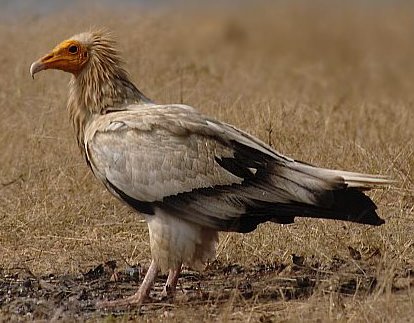These MCQs are based on Today’s Targets given here
Q.1) Consider the statements about Egyptian vultures:
1. Egyptian vultures usually build their nests on the cliffs of mountains, roofs of buildings and on tree-tops.
2. The species rarely hunt its food — the birds mostly feed on dead carcasses of animals, birds and reptiles.
3. The vultures, in the absence of animal carcasses, switch over to household solid waste like rotten fruits and vegetables.
Which of the above statements is/are correct?
a) 1 and 2 only
b) 1 and 3 only
c) 2 and 3 only
d) 1, 2 and 3
Ans. D
Explanation:
- The Egyptian vulture ( Neophron percnopterus ) is classified under the ‘Endangered’ (EN) red list of the International Union for Conversation of Nature (IUCN).
- The species is popularly known as safed giddh (white vulture) in Hindi.
- According to BirdLife International, a global partnership of organisations working for the conservation of birds, the present global breeding population of the Egyptian vulture is estimated to be 12,000 to 38,000 individuals.
- Habitat Niche : Egyptian vultures usually build their nests on the cliffs of mountains, roofs of buildings and on tree-tops.
- Food Niche of the species : The species rarely hunt its food — the birds mostly feed on dead carcasses of animals, birds and reptiles. They eat eggs and sometimes, in the absence of animal carcasses, switch over to household solid waste like rotten fruits and vegetables.
- Why in news? A new breeding centre for the species has started in Punjab University Campus.

Q. 2) Consider the following statements about Insolvency and Bankruptcy Board of India (IBBI):
1. IBBI functions under the regulatory control of Reserve Bank of India
2. IBBI will provide insolvency mechanism for listed companies only
Select the correct answer using the code given below:
a) Only 1 is correct
b) Only 2 is correct
c) Both 1 and 2 are correct
d) Neither 1 nor 2 is correct
Ans. D
Explanation:
- IBBI is the regulator for overseeing insolvency proceedings of service providers like Insolvency Professional Agencies (IPA), Insolvency Professionals (IP) and Information Utilities (IU) in India.
- It was given statutory powers through the Insolvency and Bankruptcy Code.
- It functions under Ministry of Commerce.
- The Code provides for a market-determined and time-bound resolution of insolvency proceedings.
- It became operational in December 2016.
- It covers Individuals, Companies, Limited Liability Partnerships and Partnership firms.
- It attempts to simplify the process of insolvency and bankruptcy proceedings and speed up the resolution process for stressed assets in the country.
Q. 3) Consider the following statements about Malaria:
1. It is a vector borne disease caused by virus of Plasmodium family.
2. It is most commonly transmitted by an infected female Anopheles mosquito.
Select the correct answer using the code given below:
a) Only 1 is correct
b) Only 2 is correct
c) Both 1 and 2 are correct
d) Neither 1 nor 2 is correct
Ans. B
Explanation:
- Malaria is a vector borne disease caused by parasitic protozoans belonging to the Plasmodium type.
- It is most commonly transmitted by an infected female Anopheles mosquito.
- According to the World Malaria Report 2016, India accounts for 89% of the incidence of malaria in the South-East Asia region.
- In India, malaria is caused by the parasites Plasmodium falciparum (Pf), found more in the forest areas and Plasmodium Vivax (Pv), more common in the plains.
- Most malaria cases are mainly concentrated in tribal and remote areas of the country.
- The majority of malaria reporting districts are in India’s eastern and central parts.
- Why important? Government has launched National Strategic Plan for Malaria Elimination.
Q.4) Which of the following are correctly matched :
Event Place
1. Enlightenment Bodhgaya
2. First Sermon Patliputra
3. Death Kushinara
Select the correct answer using the code given below:
a) 1 only
b) 1 and 2 only
c) 1 and 3 only
d) 2 and 3 only
Ans. C
Explanation: The Buddha belonged to a small gana known as the Sakya gana, and was a kshatriya. He meditated for days end under a peepal tree at Bodh Gaya in Bihar, where he attained enlightenment. He then went to Sarnath, near Varanasi, where he taught for the first time. He spent the rest of his life travelling on foot, going from place to place, teaching people, till he passed away at Kusinara.
Source: NCERT 6th: History – Our Past, Chapter 7, Page 65
Q.5) Consider the following statements:
1. Include extremely fine pottery
2. Generally found in the northern part of the subcontinent
3. It was black in colour
4. It has a fine sheen
Which craft is described here:
a) Northern Black Polished Ware
b) Painted Grey Ware
c) Both of them
d) None of them
Ans. A
Explanation: We also have archaeological evidence for crafts. These include extremely fine pottery, known as the Northern Black Polished Ware. It gets its name from the fact that it is generally found in the northern part of the subcontinent. It is usually black in colour, and has a fine sheen.
Source: NCERT 6th: History – Our Past, Chapter 9, Page 94